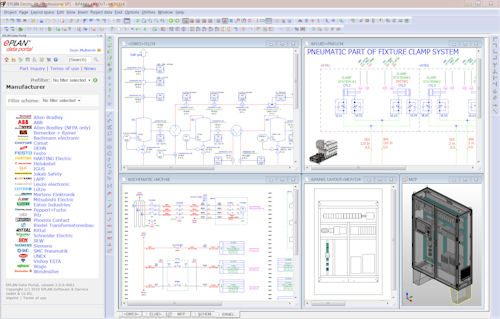Check it Out: Integrated CAE Suite for Electrical Control Design
Latest News
December 4, 2001
By Anthony J. Lockwood
Dear Desktop Engineering Reader:
I hated the word “because” for decades. See, I was a kid always into stuff. At times, such as when I toasted paper napkins to make brown paper for a project, this trait created parental perturbation. My ‘rents exacted revenge by infuriating me with a one-word dismissal of my desire to understand their ban on my experimentations: Because. That’s it! “Because.” No response to this, this word resided in the mind of a 4-year-old.
Now, I kinda like “because” because, sometimes, I go and learn about a product or an outfit because I can. Such is the case with EPLAN Software & Services and their EPLAN Electric P8 electrical design system. I had come across them before, but I had never poked too deeply at their software until one day when I made the time because I wanted to. Geez. It’s good stuff. Here’s why.
EPLAN Electric P8 is an integrated CAE suite for electrical controls system design work. It has modules for panels, fluids (hydraulic, pneumatic, lubrication, and cooling systems), instrumentation, and process control system design. It’s scalable, and it plays nice with other manufacturing applications like CAD, PLC, PLM, and ERP as well MS Office. It also incorporates what’s called the EPLAN Data Portal, which I’ll get to in a bit.
EPLAN Electric P8 is the core application. It’s been designed for its role, meaning it’s not a drafting package or a bunch of scripts that you graft onto something like AutoCAD. Rather, it’s the platform with the tools for design automation, reporting, diagrams, import/export, data management, and so on. It lets you leverage both graphical and object-oriented interfaces, so that you work in your comfort zone.
A key to understanding what benefit you could derive from EPLAN is that it automates time-consuming project tasks like wire-numbering, device-tagging, cross-referencing, error-checking, revisions management, and report generation. It can make dealing with regulatory issues easier with its ability to convert schematics to and from IEC or NFPA. And it has ways to save macros and design variants for later reuse and standardization.
Now, the EPLAN Data Portal gives you searchable access to some 250 million components from nearly 50 manufacturers, according to the company. When you find what you want, you can drag-and-drop it into your project. The neat thing is that you don’t have to make a master data set because EPLAN does it for you.
Everything I learned thus far about EPLAN Electric P8 indicates that it fosters design standards, eliminates boring tasks through automation, and does all sorts of things to make you more productive. Importantly, it seems to bring to electrical system design the concepts of operating environment, data management, productivity, and enterprise integration that the CAD jocks, analysts, and machinists have long enjoyed. This is what really caught my eye here.
See for yourself. Hit the link and go to the EPLAN Software & Services website. You’ll find videos and white papers as well as a link to a 30-day evaluation copy. I recommend that you sign-up for the eval unit for all the reasons above and, well, because.
Thanks, Pal. — Lockwood
Anthony J. Lockwood
Editor at Large, Desktop Engineering
Subscribe to our FREE magazine, FREE email newsletters or both!
Latest News
About the Author
Anthony J. Lockwood is Digital Engineering’s founding editor. He is now retired. Contact him via [email protected].
Follow DE






